
Cosworth is a British automotive engineering company founded in London in 1958, specialising in high-performance internal combustion engines, powertrain, and electronics; for automobile racing (motorsport) and mainstream automotive industries. Cosworth is based in Northampton, England, with American facilities in Indianapolis and Mooresville, North Carolina.

The Ford RS200 is a mid-engined, four-wheel drive sports car that was produced by Ford Motorsport in Boreham, UK, from 1984 to 1986. The road-going RS200 was the basis for Ford's Group B rally car and was designed to comply with FIA homologation regulations, which required 200 parts kits to be produced and at least one road-legal car to be assembled. It was first displayed to the public at the Belfast Motor Show.

The DFV is an internal combustion engine that was originally produced by Cosworth for Formula One motor racing. The name is an abbreviation of Double Four Valve, the engine being a V8 development of the earlier four-cylinder FVA, which had four valves per cylinder.
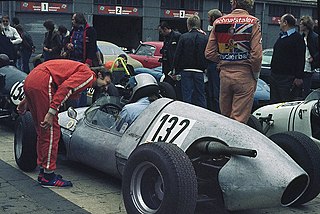
Formula Junior is an open wheel formula racing class first adopted in October 1958 by the CSI. The class was intended to provide an entry level class where drivers could use inexpensive mechanical components from ordinary automobiles. The idea to form the new class came from Count Giovanni "Johnny" Lurani who saw the need of a class for single-seater racing cars where younger drivers could take their first steps. It is often speculated that this class was founded as a reaction to Italy's lack of success in the 500cc Formula Three, and although Italian marques dominated the first year of the formula, they were soon overtaken by British constructors.

Ralt was a manufacturer of single-seater racing cars, founded by ex-Jack Brabham associate Ron Tauranac after he sold out his interest in Brabham to Bernie Ecclestone. Ron and his brother had built some specials in Australia in the 1950s under the Ralt name. Tauranac won the 1954 NSW Hillclimb Championship in the Ralt 500.

The Lotus 23 was designed by Colin Chapman as a small-displacement sports racing car. Nominally a two-seater, it was purpose-built for FIA Group 4 racing in 1962–1963. Unlike its predecessors Lotus 15 and 17, the engine was mounted amidship behind the driver in the similar configuration developed on Lotus 19.

The Clubman is a class of prototype front-engined sports racing cars that originated in Britain in 1965 as a low-cost formula for open-top, front-engined roadgoing sports cars like the Lotus 7, which had been crowded out of the mainstream by rear-engined cars such as the Lotus 23.

The Lotus 22 was a racing car built by Lotus cars in 1962, and a total of 77 cars were built. It was developed from the 1962 Lotus 20, with the major differences that it had disc brakes all round, a top link and the 'rubber donut' to the rear suspension and a dry sump engine that was canted over to lower the centre of gravity. Also notable is the smoother bodywork covering the engine, compared to the boxy design of the 20.
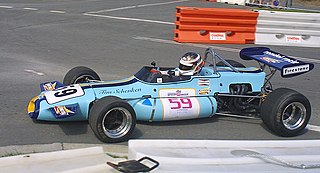
The Brabham BT36 was an open-wheel Formula 2 race car, designed by Ron Tauranac, and developed and built by British racing team and constructor, Brabham, for the 1971 European Formula Two Championship. Its best result that season was a 2nd-place finish in the championship for Argentine Carlos Reutemann, despite only winning one race, taking one pole position. His consistency and pace made up for this, scoring 6 podium finishes, and finishing the season with 40 points. The Brabham BT36 was constructed out of a complex tubular space frame, and was powered by the naturally-aspirated 1.6 L (98 cu in) Ford-FVA Cosworth four-cylinder engine, which produced 220 hp (160 kW), and drove the rear wheels through a 5-speed Hewland F.T.200 manual transmission.
The March 75A was an open-wheel formula racing car, designed, developed and built by British manufacturer and constructor, March Engineering, for Formula 5000 racing, in 1975. It was based on the March 761 Formula One car. Unlike most other F5000 cars of the time, which used 5.0 L (310 cu in) V8 engines, the 75A used a smaller 3.4 L (210 cu in) Ford-Cosworth GAA V6 engine, which produced between 420–470 hp (310–350 kW) @ 9,000 rpm, depending on tuning and spec. Engines up to 5,000 cc (310 cu in) could be used, so this was still perfectly in line with the regulations.
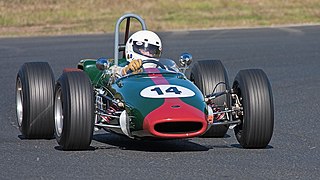
The Brabham BT14 was an open-wheel mid-engined formula racing car, designed, developed and built by British manufacturer and constructor Brabham, in 1965. A total of 10 models were produced. It was specifically constructed to compete in Formula Libre racing. It competed in motor racing between 1965 and 1968; winning a total of 10 races, scoring 22 podium finishes, and clinching 4 pole positions. It also contested the 1967 European F2 Championship season, competitng in 7 races, but with no success; scoring no wins, pole positons, podium finishes, or scoring any points. It was powered by a naturally-aspirated 1.6 L (98 cu in) Ford twin-cam four-cylinder engine, which droves the rear wheels through a conventional 4-speed manual transmission.

The Ford-Cosworth Indy V8 engine is a series of mechanically similar, turbocharged, 2.65-liter, Indy car racing V-8 engines, designed and developed by Cosworth in partnership with Ford. It was produced for over 30 years. It was used in U.S.A.C. Championship Car, C.A.R.T., and later Champ Car World Series; between 1976 and 2007. The DFX engine was the Indy car version of the highly successful 3-liter Cosworth DFV Formula One engine developed by former Lotus engineer Keith Duckworth and Colin Chapman, with financial backing from Ford for the Lotus 49 to campaign the 1967 season. This engine had 155 wins between 1967 and 1985 in F1. The DFX variant was initially developed for Indy car use by Parnelli Jones in 1976, with Cosworth soon taking over. This engine won the Indianapolis 500 ten consecutive years from 1978 to 1987, as well as winning all USAC and CART championships between 1977 and 1987. It powered 81 consecutive Indy car victories from 1981 to 1986, with 153 Indy car victories total.
The Matra MS1 was Matra's first open-wheel formula racing car, and was built in 1965. It was powered by a naturally aspirated, 997 cc (60.8 cu in), Cosworth MAE inline four-cylinder engine, producing 100 hp (75 kW), mated to a 5-speed Hewland T.L.200 manual transmission, that drove the rear wheels. The body is constructed out of lightweight fiberglass, and the chassis is an aluminum monocoque.
The Cougar C02 was a Group C sports car prototype race car, designed, developed, and built by French constructor Cougar in 1983, and used in sports car racing from 1983 to 1984. It was the successor the C01. Its best result was at the 1984 500 km of Watkins Glen, where drivers Yves Courage and John Jellinek, and Alain de Cadenet finished in 9th-place, respectively.
The Sauber C2 was the second prototype racing car that Swiss Peter Sauber designed and developed. It was built in 1971. It scored three race wins and seven podium finishes. It was powered by a naturally aspirated 1.6 L (98 cu in) Ford-Cosworth BDA four-cylinder engine, with 240 hp (180 kW). It was also very light, weighing only 480 kg (1,060 lb).
The Sauber C3 was the third sports prototype racing car that Swiss Peter Sauber designed and developed. It was built in 1973. It scored one race win, seven podium finishes, clinched one pole position, and achieved 3 additional wins in its class. It was powered by a naturally aspirated 2.0 L (120 cu in) Ford-Cosworth BDG four-cylinder engine, developing 280 hp (210 kW).
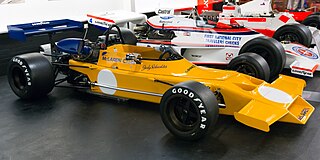
The McLaren M21 is an open-wheel race car, designed and developed by Australian designer Ralph Bellamy, and built by British constructor and racing team, McLaren, to compete in the European Formula Two Championship in 1972. It was designed to be lower, flatter, and squarer, and more aggressive in stance and design than its predecessor, with the monocoque being positioned, but still retained the regular front-and-rear outboard suspension.It was driven by South African Jody Scheckter. It won one race, at Crystal Palace in 1972, with Scheckter eventually finishing 8th-place in the championship, scoring 15 points. It, unfortunately, suffered numerous mechanical and technical problems, including engine failures and handling problems, which prevented it from winning more races. It was powered by either a naturally aspirated 1.6 L (98 cu in) Ford-Cosworth BDA four-cylinder engine, tuned to produce 210 hp (160 kW), or a larger bored-out 1.9 L (120 cu in) Ford-Cosworth BDF, tuned to develop 271 hp (202 kW).
The McLaren M25 was an open-wheel racing car, designed by John Barnard, and developed and built by British constructor McLaren in 1973. It was based on the successful McLaren M23 Formula One car. It was originally built with the intention to be a Formula 5000 car, but it did not compete in any F5000 races, and didn't even contest in a motor race until 1976, which by that, was too late, since Formula 5000 racing had folded. It then became a Formula One car for Emilio de Villota, and was equipped with a 3.0 L (180 cu in) Ford-Cosworth DFV V8 engine, where it only entered one World Championship Grand Prix, the 1978 Spanish Grand Prix. de Villota damaged the car in an accident during the practice session for the race, so the team reverted his car back to the M23.

The Chevron B16 was a Group 4 sports prototype race car, designed, developed, and built in 1969 by the British racing car manufacturer Chevron Cars as a two-seater racing sports car for the makes world championship. Brian Redman won the very first outing, the 500 km (310 mi) race at the Nürburgring on September 7, 1969, at a time of 3:13:01.6 hours. The last victory with a Chevron B16 was achieved by Clemens Schickentanz on July 11, 1971, in the sports car race at the Norisring.
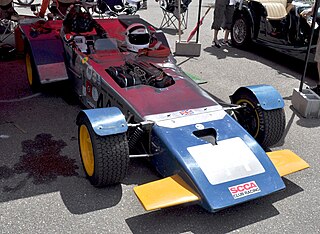
The Mallock Mk.XI, also designated as the Mallock Mk.11, is an open-wheel formula racing car, developed and built by Ray Mallock Ltd., in 1970. It was specifically designed and constructed to compete in the Clubman category and class; which catered to front-engined sports prototype race cars. It was also later used in Formula Three racing. It was powered by a naturally-aspirated 1.6 L (98 cu in) Ford-Cosworth FVA four-cylinder engine, producing approximately 220 hp (160 kW).















